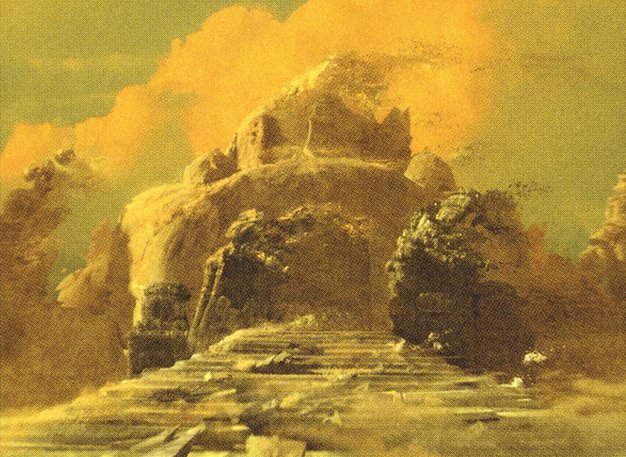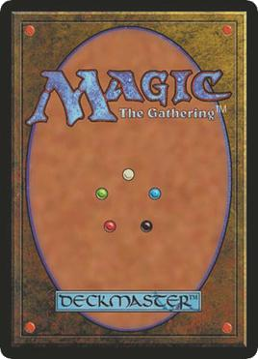 Art by Eytan Zana
Art by Eytan Zana360 Paper Cards - Mainly Legacy Restrictions (with a few exceptions) - No Budget Restrictions
Welcome to Base Cube - a basic cube and building block
The Base Cube is (mainly) a standard Legacy legal cube environment with all the beloved archetypes that one can and should expect. This 360 card cube features all classic / generic archetypes reknown from WotC Legacy/Vintage cubes with one exception for the Rakdos Guild (BR) explained below.
The name "Base Cube" is intentional. The Base Cube is the basic building block for 2 additional extensions which extend this very cube up to 720 cards thus adding a more Vintage like feeling or simply providing more fun archetypes. If you want to read more about extensions skip ahead. Also if you're interested in my Design Goals & Decisions please head to the next section.
Table of Contents:
1.Welcome to Base Cube - a basic cube and building block
6.Two Player Drafts and other Draft Stuff
My Playgroup and History
My play group includes mostly experienced and long-time Legacy players and I want to design a good play experience for them with cards that they know and love. On top of that, designing for now-and-then players tends to benefit all players.
I assembled the 360 card Base Cube 2017 from cards I already own from my extensive Legacy collection. Then seeing MTGO Vintage cube and many other cubes on Cubetutor (RiP) I quickly came up with extension packs to it. SEE BELOW if you want to learn more about that topic.
Initially I didn't think too much about player attendance but in retrospect the most fun cube drafts are of course 8 player drafts while the most often and intricate experience is with 2 players. 4 players is also possible but most difficult in my opinion. Often you have to do burn drafts (pick 1 - burn 1) and hate-pick a lot of cards. Therefore specific archetypes tend to become quite bad or near undraftable especially if you want to go for Combo. Nevertheless burn drafting with 4 people is very skill-intensive.
Initially the base cube featured an additional booster to tutor with e.g. Booster Tutor. But due to negative feedback from my playgroup which considered drafting a single booster with 8 players too time consuming and boring it was removed: Note: The extensions still feature additional booster packs (Sapphire and Ruby Booster).
Base Cube and Extensions
The Base Cube can be extended to a 540 card Legacy cube using the Legacy Cube Extension adding more archetypes. It can also be extended to a 540 card Vintage cube which I keep very close to current MTGO Vintage cube. You can find it here: Vintage Cube Extension. Hence the name for this cube "Base Cube" as it is always needed as a BASE for all extensions. You can also mix everything together for a 720 card cube. Each extension comes with its own 16 cards extra booster that is added to a draft either via Booster Tutor or Lore Seeker. So the actual size of each expansion is 556 cards. Extra boosters contain 16 cards so in a 8 player draft everybody gets 2 cards from it.
The individual extensions (Vintage, Legacy) are not playable on itself. They contain just 180 cards plus their extra booster. However the 556 card Big Legacy Cube and the 556 card Big Vintage cube are online and can be drafted on CubeCobra. The 720 card cube of everything put together is not available.
In paper extension cards are tagged with extensions symbols on the inner sleeve to distinguish between them (Base Cube cards do not have any extra symbol). Extension boosters are also individually tagged.

[from left to right: card from Vintage extension, card from Legacy extension, card from Legacy's extension Ruby Booster, card from Vintage's extension Sapphire Booster]
Why extensions?
Depedending on player attendance and what you're up to, different cube sizes and themes are preferable. A 360 card cube is ideal for, well, almost everyting. Spicing it up to be a Vintage Cube or 540 cards in general for a bit of randomness is of course something we do quite often. If you want to keep it more fair take the Legacy extension. If you want to have it all or perform two 8 player drafts in a row do all 720 cards. You can also take the randomness of a 540 Vintage cube and seed the Power 9 or whatever you deem necessary before shuffling the cube (that's how WotC does it).
What are the downsides?
Working with extensions makes cube design a little harder as you have to preserve the boundaries or boxes around each set (Base, Vintage Extension, Legacy Extension). You have to think about things like which cards are better in which environment or which card really deserves to be played in all drafts and therefore be part of the Base Cube. Often good cards are promoted to the base cube (e.g. Shark Typhoon) if they prove to be a valuable base cube addition and sometimes they are downgraded if they prove a rather format specific addition (e.g., Birgi, God of Storytelling).
Note: I started to do an all alternate art version of the Base Cube which can be found here: Altered Base Cube. This is mainly to capture the feeling of opening a pack and being excited by not knowning (or recognizing) what's inside.
Design Goals & Decisions
The Base Cube archetypes are staples of cubes everywhere. It is especially designed to provide a common average and does not feature a lot of indiviual card preferences. SEE THE PRIMER further down this page if you are not familiar with how these classic archetypes tend to play out in the draft and on the table.
There is however one exception to this rule in RB which features an aristocrats style archetype. Rakdos serves this zombie- and vampire-heavy archetype and not some boring RB aggro soup (you can play it though or go for RB Reanimator). It also extends into WB Tokens/Stax. Unfortunately Zombies and Vampires on their own are lacking power and are quite parasitic for cube (like Storm in Vintage). In order to strenghten afore mentioned archetype and reduce its parasitic nature a new tribe subsumes all undead tribes into one. This ensures the new tribe called "EVIL DEAD" is powerful enough to be valid in my cube environment and contains sufficient generalistic cards to promote cross-pollination. Here is a world enchantment or reminder card that is always on, cannot be targetted or removed. It simply exists and affects every game in my cube:

Note: Over time additional creature types have been included which are clearly Undead creatures like: Necrons, Phyrexians or Shades. Such cards are tagged as "Undead" in the cube.
Other Design Space Considerations
There are more design consideration having to do more with style and accessibility or with the design for different extensions.
- Cards are from original editions in which they were printed first (ignoring alpha / beta for pricing reason)
- Cards shoud be in English or German because that's the languages my playgroup understands
- Cards are among popular choices for this slot (using popularity rating and recommendations from CubeCobra)
- Cards in the Base Cube are available to ALL EXPANSION as the base cube is always in the mix. This means that sometimes choices are hard when a card needs to be a base card and changing it here must also consider other environments
- Card legality does not always matter to build working archetypes. There are currently 7 cards in the base cube which are technically not legal in Legacy but which are required for certain archetypes or cards to make sense and for availability reasons in either of the two extensions. Typically these are strong cards but as a 1 Off not as oppressing as they would be in tournament decks as a 4 Off. These cards currently are Ragavan, Nimble Pilferer (Burn), Survival of the Fittest (RecSur), Wrenn & Six (Land Recursion), Skullclamp (Token Decks), Sensei's Diving Top (general purpose card), Strip Mine (Land Recursion), Dig Through Time and Gitaxian Probe
Then there are some basic cube design consideration I take into account:
- No traps or signaling archtetypes that aren't there
- Balance between Combo, Control and Aggro
- Thinking of 2 player drafts. SEE BELOW FOR MORE CONSIDERATIONS ON TWO PLAYER DRAFTS
- Breaking cycles is fine (e.g. with Swords in older cube incarnation or with Signets)
- Limiting Planeswalkers, Protection, & Mill. You won't find cards like True-Name Nemesis or Mirran Crusader. Most color just features 2 planeswalkers.
Supported Archetypes
Here is a list of reknown 1 and 2 color archetypes Base Cube supports but also 3 color combination like Esper or Sultai are quite common options. In brackets you'll find the relativ strength of all mono and dual-colored standard archtypes rated weak/medium/strong.
 WeenieGeddon (strong)
WeenieGeddon (strong)
 Orzhov - TokenStaxx (medium)
Orzhov - TokenStaxx (medium)
 Selesnya - GoodStuff (weak)
Selesnya - GoodStuff (weak)
 – Boros Aggro (strong)
– Boros Aggro (strong)
 – Classic UW Control (strong) / UW Tempo (medium)
– Classic UW Control (strong) / UW Tempo (medium) – Mono U Control (medium)
– Mono U Control (medium)
 – Twin Combo / Sneaky Things / Upheaval (strong)
– Twin Combo / Sneaky Things / Upheaval (strong)
 – UB Control (medium) / Reanimator (strong)
– UB Control (medium) / Reanimator (strong)
 – UG Goodstuff / Opposition (medium)
– UG Goodstuff / Opposition (medium)
 – RecSur (medium)
– RecSur (medium) – Burn (medium) / Big Red (medium)
– Burn (medium) / Big Red (medium)
 – Aristocrats (medium) / RB Aggro (medium) / Aggro Discard combined with Reanimator (strong)
– Aristocrats (medium) / RB Aggro (medium) / Aggro Discard combined with Reanimator (strong)
 – R/G Ramp (medium) / Midrange (weak)
– R/G Ramp (medium) / Midrange (weak) – Ramp n Cheat (strong)
– Ramp n Cheat (strong) – Removal & Critters (medium)
– Removal & Critters (medium)
The following, slighty outdated PDF contains typical cards and key / signal cards of each archetype in the Base Cube. As these are standard archetypes I leave you with searching the web for a more indepth view into each of them. However here is a list of supported comboes as this very often differs:
Combo Pieces
Kiki / Twin Combo main pieces:
Sneak & Show main pieces
Reanimator main pieces:
Best monsters to cheat into play:
Aristocrats combo pieces:
Typically we are playing Winston Draft, a specific 2 player draft format developed by Richard Garfield, sometimes Grid or normal Pack drafts with 7-9 cards per pack depending on time constraints. Winston Drafts usually take longest and you can perform 3 drafts with 120 cards each. Grid drafts we go for 180 cards (2 drafts), same for pack drafts as we usually do pick 2, burn the rest. We often take the 540 card Big Vintage Cube (Base Cube + Vintage extension) and size it back down to 360 cards after shuffling. Seeding the cube is crucial in my experience since you want all the pieces of power in.
However there is another huge problem at 2 players. Card accessibility especially for Combos is very difficult. This can also be extended to properties like critical mass in 1 and 2 drops for archtypes like Mono W or R. Therefore we started to incoporate so called Regalia cards into our drafts (an idea from Brandon Sanderson) to make non-accessible cards accessible through certain types of tutors that you can exchange for cards outside the draft after drafting but before deck-building. There is of course a sleight disadvantage here in that your opponent sees what cards you choose and might deduct on what archetype you are. However it makes play experience and deck building so much better that these days we never play without Regalia cards (at least with 2 players). With 8 players you can also do the same when you start with a 540 card cube (otherwise there are no outside the draft cards) but not everybody likes the experience and Regalia tutors tend to be very very strong (e.g. take the best card out of 180).
To give you an idea here are some of the Regalia card tutors:

Tutors based on color are very good option for 8 player drafts where you are picking from boosters. In 2 player Winston drafts the variance is too high for these tutors as it can be suberb if it fits your drafted colors or shitty otherwise.
Tutors based on type are a very good option for Winston drafts to find missing pieces but are sometimes too powerful for normal drafts were you already see much more of the cube's cards. Especially artifact and instant/sorcery tutors tend to be too powerful. Keep in mind that this is especially true when adding the Vintage Cube extension.
How do Regalia cards work for Winston Draft?
A basic description of the Winston draft method can be found here: https://mtg.fandom.com/wiki/Winston_Draft
Different from these basic rules is that we add a fourth pile of cards to the end of the line called the Regalia card pile. Instead of drawing a card from the library stack as a default action if you pass on all other card piles, the default action is now to take one Regalia card. Regalia cards contain tutors like the ones mentioned above and specific 2 player format Regalia cards like the following in a 50/50 mix:

These cards either mimick conventional library stack actions or give a special bonus. Tutor cards are applied to all (240 for a 360 card cube) cards outside the 120 card draft. They can be exchanged after the draft but before deck building with actual cards that match the tutors description. Resolving these cards is done openly, one at a time and in turns. You just have to remember the pile from which you take them to put them back later. This considerably improves your decks capabilities to combo, smooth color availability or other things. However there is a costs to pay: Passing on all 3 piles before you come to the Regalia pile can be a steep cost. Especially so if you are just not getting a tutor but a random draw.
Misc things
How I shuffle the cube:
https://www.reddit.com/r/mtgcube/comments/34fet8/novel_method_for_shuffling_a_cube/
Untouchables:
In Vintage cube typically the Power 9. These cards are taken out before reducing the cube from 540 to 351 and are put back in afterwards (a process called seeding).
Stipulation drafts using selfmade colorless Companion cards: https://www.mtg-forum.de/topic/171062-stipulation-drafts-mit-selbstgemachten-companions/
Example:
Horde Martyr - Companion - 2
Your starting deck contains at least 15 creature cards.
When Horde Matyr enters the battefield creatures you control get +2/+0 until end of turn.
Sacrifice Horde Matyr: Creatures you control gain indistructable until end of turn
3/1
More things I tried out in drafting (German only):
https://www.mtg-forum.de/topic/163647-umgang-mit-der-situation-nicht-den-gesamten-cube-draften-zu-k%C3%B6nnen/
And that's all for now, folks.
I wanted to have Tidebinder in. Spelljacker turned out to be quite expensive. So he is dempoted to the Legacy extension.
Captain is going to the Vintage extension to have less cards like intiative / monarch in the base cube. Flametongue comes back - another aggressive creature like Hellrider does make less sense imho.

